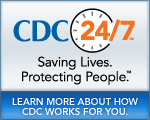MMWR
Morbidity and Mortality Weekly Report
MMWR News Synopsis for March 18, 2010
- (Box) World TB Day a€“ March 24, 2010
- Decrease in Reported Tuberculosis Cases a€“ United States, 2009
- Monitoring Tuberculosis Programs a€“ National Tuberculosis Indicator Project (NTIP), United States, 2002-2008
- Investigational Heptavalent Botulinum Antitoxin (HBAT) to Replace Bivalent Botulinum Antitoxin AB and Investigational Botulinum Antitoxin E
There is no MMWR telebriefing scheduled for March 18, 2010.
1. (Box) World TB Day a€“ March 24, 2010
CDC
National Center for HIV/AIDS, Viral Hepatitis, STD, and TB Prevention
(404) 639-8895
No summary available.
2. Decrease in Reported Tuberculosis Cases a€“ United States, 2009
CDC
National Center for HIV/AIDS, Viral Hepatitis, STD, and TB Prevention
(404) 639-8895
Although preliminary, latest national tuberculosis (TB) data for 2009 indicate a marked decrease in the number of TB cases reported in the United States. Preliminary TB surveillance data for 2009 show an 11.4 percent decrease in the reported TB case rate from 2008, whereas the average annual decline over the past eight years was 3.8 percent. Many factors, ranging from better disease control measures to possible under-reporting, are being reviewed to determine what may have caused such a significant change. CDC is currently examining the National TB Surveillance System for evidence of reporting changes; searching laboratories and pharmacy databases and sites such as prisons and healthcare facilities to identify any unreported TB cases; and coordinating with the National TB Controllers Association, and other city, county, and state health officials to determine whether changes in budget or staffing have affected TB case reporting or case-finding. Authors note that regardless of this decline in reported TB cases, the public health community must remain vigilant to protect those who are disproportionately affected by this disease, including minorities and foreign-born individuals. Authors also encourage the appropriate precautions to guard against the resurgence of TB and the development of drug-resistant TB.
3. Monitoring Tuberculosis Control Programmatic Activities a€“ The National Tuberculosis Indicator Project (NTIP) a€“ United States, 2002-2008
CDC
National Center for HIV/AIDS, Viral Hepatitis, STD, and TB Prevention
(404) 639-8895
CDC surveillance data shows that, overall, TB case management has improved in the United States. In 2009, CDC launched The National Tuberculosis Indicators Project (NTIP), a web-based monitoring system that uses surveillance data to measure the performance and effect of state and local tuberculosis (TB) control programs. The system began in 2006 when representatives of state and local health departments, the National TB Controllers Association, and CDC identified 15 categories of national program objectives highlighting priority activities and outcomes and set performance targets for 2015. The system was launched using retrospective data through 2000 to help programs track progress. From 2004 to 2008, the years for which the most recent and complete data are available, performance improved in five of the seven indicators related to TB case management; including, recommended initial therapy, genotyping, human immunodeficiency virus status, sputum culture reporting, and culture conversion. Indicators remained unchanged for treatment completion rates for persons with active disease, and declined in for reporting rate of the initial drug susceptibility test results.
4. Investigational Heptavalent Botulinum Antitoxin (HBAT) to Replace Bivalent Botulinum Antitoxin AB and Investigational Botulinum Antitoxin E
CDC
Division of Media Relations
(404) 639-3286
No summary available.
- Historical Document: March 18, 2010
- Content source: Office of the Associate Director for Communication
- Notice: Linking to a non-federal site does not constitute an endorsement by HHS, CDC or any of its employees of the sponsors or the information and products presented on the site.
View Press Releases in
Get e-mail updates
To receive e-mail updates about this page, enter your
e-mail address:
Contact Us:
- Centers for Disease Control and Prevention
1600 Clifton Rd
Atlanta, GA 30333 - 800-CDC-INFO
(800-232-4636)
TTY: (888) 232-6348 - Contact CDC-INFO


